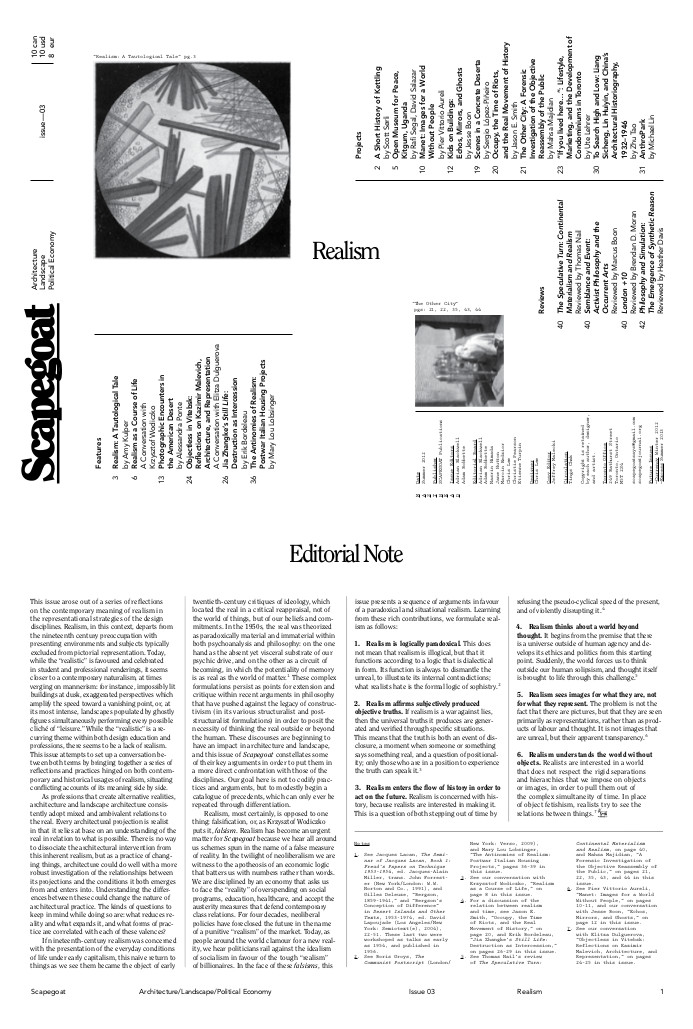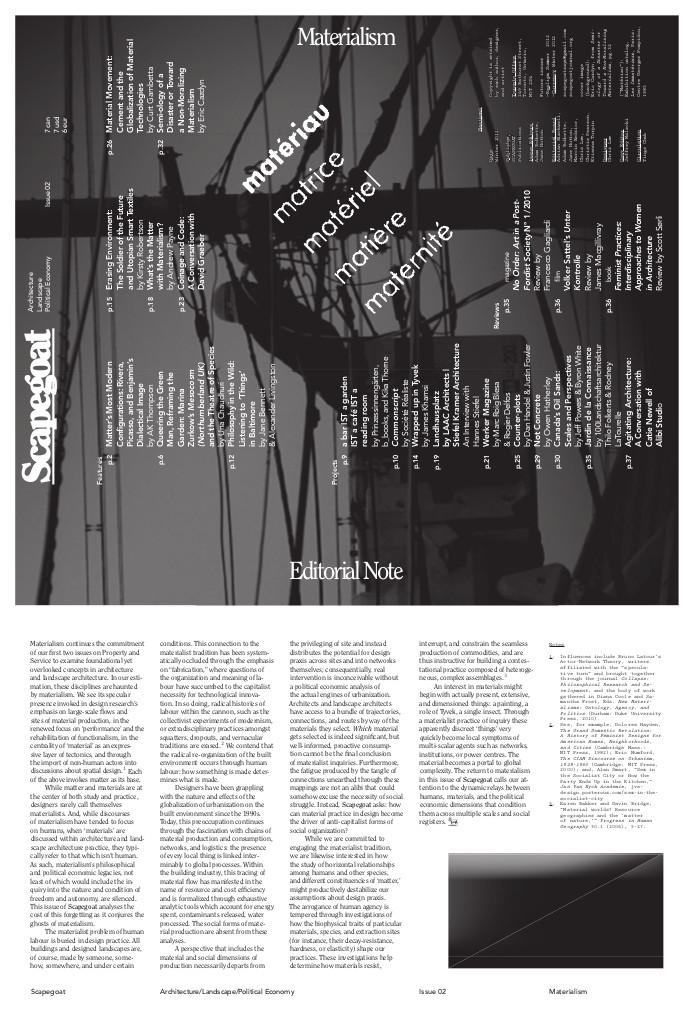Scapegoat: Architecture/Landscape/Political Economy journal, No. 2: Materialism, No. 3: Realism (2011-2012)
Filed under journal | Tags: · architecture, capitalism, city, design, landscape, materialism, philosophy, political economy, politics, urbanism

“This issue arose out of a series of reflections on the contemporary meaning of realism in the representational strategies of the design disciplines. Realism, in this context, departs from the nineteenth century preoccupation with presenting environments and subjects typically excluded from pictorial representation. Today, while the ‘realistic’ is favoured and celebrated in student and professional renderings, it seems closer to a contemporary naturalism, at times verging on mannerism: for instance, impossibly lit buildings at dusk, exaggerated perspectives which amplify the speed toward a vanishing point, or, at its most intense, landscapes populated by ghostly figures simultaneously performing every possible cliché of ‘leisure’. While the ‘realistic’ is a recurring theme within both design education and professions, there seems to be a lack of realism. This issue attempts to set up a conversation between both terms by bringing together a series of reflections and practices hinged on both contemporary and historical usages of realism, situating conflictng accounts of its meaning side by side.” (from the Editorial Note)
Issue 3: Realism
Summer 2012
Issue Editors: Adrian Blackwell, Adam Bobbette
42 pages

“Materialism continues the commitment of our first two issues on Property and Service to examine foundational yet overlooked concepts in architecture and landscape architecture. In our estimation, these disciplines are haunted by materialism. We see its specular presence invoked in design research’s emphasis on large-scale flows and sites of material production, in the renewed focus on ‘performance’ and the rehabilitation of functionalism, in the centrality of ‘material’ as an expressive layer of tectonics, and through the import of non-human actors into discussions about spatial design. Each of the above invokes matter as its base.” (from the Editorial Note)
Issue 2: Materialism
Winter 2011
Issue Editors: Adam Bobbette, Jane Hutton
Publisher Scapegoat Publications, Toronto
40 pages
Scapegoat: Architecture/Landscape/Political Economy journal, No. 0-1 (2010-2011)
Filed under journal | Tags: · architecture, city, creative city, gentrification, landscape, political economy, politics, urbanism

“The second issue of SCAPEGOAT looks to current practices to intensify our concept of Service—as a problem. That is, how can we develop new models for self-management and mutual aid that move beyond unidirectional forms of service as clientelism and dependency? How can we think through service provision beyond the State? How can we privilege voluntary association and ethical reciprocity rather than volunteerism? How can new approaches to training and the intergenerational transmission of knowledge be radically re-organized? How has the rise of the populist Right coincided with mechanisms of gentrification and the ideologies of the so-called ’creative city’? How can we counter the predominance of economic metaphors in our attempts to articulate values and commitments? How could design services work in solidarity with the labour of extraction, construction, and maintenance?” (authors)
Issue 1: Service
Summer 2011
Editors: Jane Hutton, Etienne Turpin
28 pages

“The inaugural issue examines the centrality of the problem of Property because it is the literal foundation for all spatial design practices. We believe that this buried foundation must be exhumed. Architecture, landscape architecture, and urban design each begin with a space that is already drawn, organized, and formed by the concrete abstraction of the property lines. From our perspective, Property stands as the most fundamental, yet underestimated, point of intersection between architecture, landscape architecture, and political economy. What is a “site” except a piece of property? What are architecture and landscape architecture but subtle and consistent attempts to express determined property relations as open aesthetic possibilities? And, decisively, how can these practices facilitate other kinds of relation?” (authors)
Issue 0: Property
Fall 2010
Editors: Adrian Blackwell, Etienne Turpin
24 pages
SCAPEGOAT: Architecture | Landscape | Political Economy is an independent, not-for-profit, bi-annual journal designed to create a context for research and development regarding design practice, historical investigation, and theoretical inquiry.
As a mytheme, the figure of the scapegoat carries the burden of the city and its sins. Walking in exile, the scapegoat was once freed from the constraints of civilization. Today, with no land left unmapped, and with processes of urbanization central to political economic struggles, SCAPEGOAT is exiled within the reality of global capital. The journal examines the relationship between capitalism and the built environment, confronting the coercive and violent organization of space, the exploitation of labour and resources, and the unequal distribution of environmental risks and benefits. Throughout our investigation of design and its promises, we return to the politics of making as a politics to be constructed.
Publisher: Scapegoat Publications, Toronto
Editorial board: Adrian Blackwell, Adam Bobbette, Jane Hutton, Marcin Kedzior, Chris Lee, Christie Pearson, Etienne Turpin

